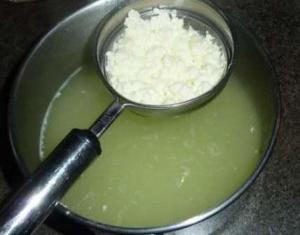Whey syrup as a protein supplement for bees

Syrup is prepared for feeding bees in the winter on whey instead of ordinary water. It is known that by the winter bees should increase their reserves of fats and proteins, the so-called protein-fat body. In the presence of such reserves, they winter better and develop better in early spring.
Whey is a by-product in the preparation of cottage cheese, cheese, casein, and depending on the type of milk coagulation, it can be bland or acidic. Acid whey is obtained after curdling milk with lactic acid. Unleavened whey is obtained by curdling milk with the help of special enzymes.
The composition of whey is variable, as it depends on the quality of milk and on the characteristics of the technological process. Usually fresh whey contains 93.7% water and about 6.3% dry matter, of which 0.5% are fats, 0.8% various proteins (they are mainly represented by albumins and globulins), 4.85% lactose, 0.5% mineral salts and 0.05% lactic acid. In sour whey, lactic acid is 10 times more.
Usually, 64-71 liters of whey is obtained from 100 liters of milk, which depends on the specifics of production, mainly on the method of straining. In some places, whey is eaten (they cook okroshka, prepare dough for pies and bread on it, and finally, they just drink it like kvass).
Based on the composition, it can be assumed that whey can be used as food and for bees as a sugar solvent, which is quite justified. Moreover, fresh whey, as mentioned above, includes fats, proteins and milk sugar (lactose). The syrup is prepared in the traditional way.
The long-term use of such syrup in the apiary has shown that colonies fed with whey syrup overwinter much better than when fed syrup on water. Making syrup with whey is no different from making syrup with water. The proportion of sugar and liquid depends on local conditions, so in August syrup is prepared in a ratio of 3: 2 (sugar - whey). It is better to prepare syrup the day before distribution, i.e. the prepared syrup remains ready-made until the next day. It should be handled carefully, as with any dairy product: all work must be done in a cold place so that the syrup does not turn sour.
Whey can be obtained from the nearest dairy.
The processing of sugar into syrup can also be done in the traditional way, i.e. on water, and add whey later. Its quantity and concentration will be less.
Pure whey syrup is a quality product that does not contain any genetically modified organisms, so it is a very healthy food and even medicine (for humans). Its use in practice gives good wintering results for many years. Unfortunately, there are no scientific studies and recommendations on this subject to confirm this subjective assessment of beekeepers.
p.s.
Whey is obtained as a by-product in the production of homemade cottage cheese or cheese.
Whey is prepared from fresh cow's milk by fermenting it at a temperature of 20-25 degrees for 48-60 hours. After removing the fat layer, the whey is heated to 65-80 degrees, cooled to room temperature and then filtered through 1-2 layers of gauze. The resulting serum in an enamel bowl is kept for 4-5 days at 25 degrees or three days at 35 degrees, then again filtered through several layers of gauze.
The process of preparing whey from goat milk is similar.
The resulting whey, in addition to preparing a syrup, is used for spraying bees, for the prevention of foul diseases. Spray frames with serum from a spray bottle. In the evening or in the morning at a temperature not lower than 15 degrees. Consumption per frame, 15-20 ml of serum. In case of detection of signs of foulbrood diseases, the treatment must be repeated after 12-15 days. The results are checked 25-30 days after application.
